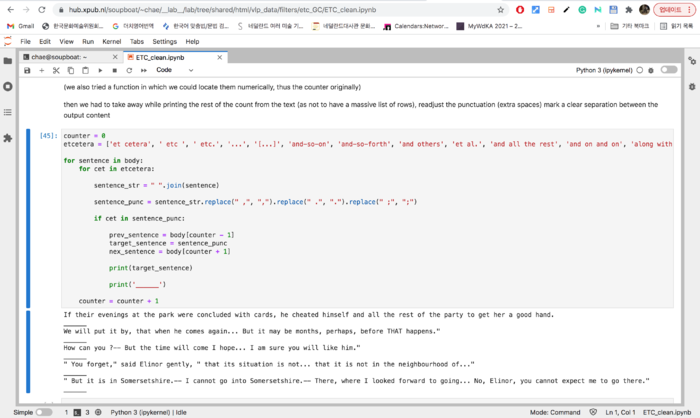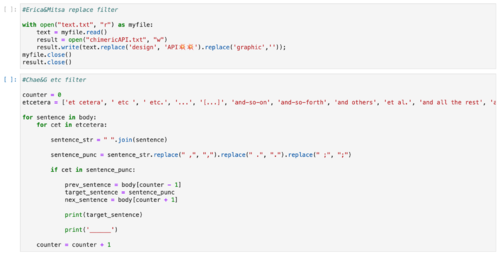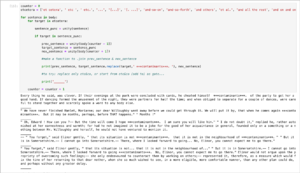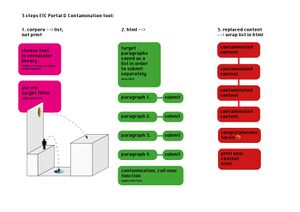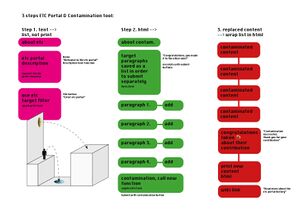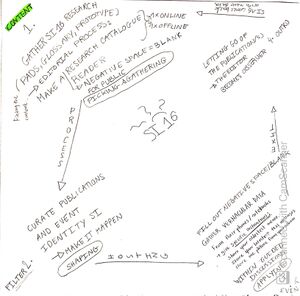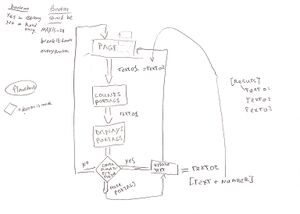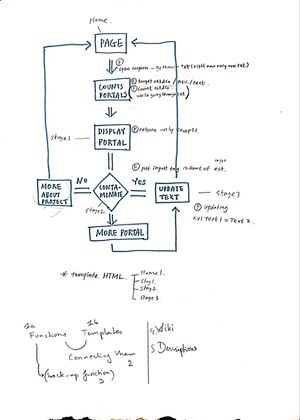Etc Portal to Contamination
C is Chae = ['채영', '챙', '챙챙', '챙챙챙', '채니', 'Chae', 'Chaeyoung', 'Chaiyoung', 'Chae as Che Guevera', 'tsjeejong', 'Chany']
G is Gersande = [aka. 'Gerry', 'Gi', 'Gigi', 'Gege', 'Ger', 'Jessmondl', 'Chester', 'Sandge', 'Pierre-cendre', 'Gersandre', 'Jackson']
The Etc Portal
Definition
etc. /ɛtˈsɛtərə/ adverb adverb: etc.; adverb: &c. used at the end of a list to indicate that further, similar items are included. "protect seedling from damage caused by feet, lawnmowers, pets, etc." (Oxford Dictionary)
Et Cetera, abbreviated to etc., etc, et cet., &c. or &c is a Latin expression that is used in English to mean "and other similar things", or "and so forth". Translated literally from Latin, et means 'and', while cētera means 'the rest'; thus the expression translates to 'and the rest'. (Wikipedia)
Description
On The Other Side
Definition
On The Other Side
on the other side you are in a face to face with the excerpts list that is an outcome of the etc portal function.
Description
The etc portal is first of all a target function.
The Contamination Tool
Definition
contamination
contamination is the presence of a constituent, impurity, or some other undesirable element that spoils, corrupts, infects, makes unfit, or makes inferior a material, physical body, natural environment, workplace, etc.(Wikipedia)
contamination tool The contamination tool aims to give you the agency over any text, in this case a custom text, to add contaminants (aka. contributions) directly into the text, with no distinction between the original content and the added one. The contaminated text will thus grow and change, with a seamless design as to it's skeleton and the added flesh. A tool for co-authorship or textual piracy. (G)
Description
The Ethics of Contamination
History
overview etc project
what kind of entry point
week 6, etc filter as an entry point
The etc filter, a method that will unravel, a gate to look into rejected spaces, a starting point.
An etc. filter as an entry point/door to address/look into negative space/rejected space (C: need more explanation about what do we mean by negative space) which can be a starting point, yet to be defined.
Around week 6, C and G were still more leaning towards rejection rather than etc. Or at least etc as a gate to rejected space.
how it started
week 7, 1st of November / prototyping class
The Special Issue 16 unfolds under the subject(s) of vernacular language. All classes, online/offline contents and intervenor XPUB1 has had the last few months had some input within the subject. As a group, very early in our process we decided to investigated the topic of Rejection in relation to the theme of Vernacular language.
In the beginning, G's interest in the rejection list was rejection as a starting point, and C's was: rejection as a turning point-a trigger for an action/a change/a different direction.
C was stuck with the word, 'et cetera' because:
1) Michel Foucault Order of Things (Preface)
2) Despite 'et cetera being frequently used in our daily life, it has been somewhat neglected and considered improper.
And C was curious to know what goes under this ambiguous category, et cetera(and others) boundary.
G's interest started from the work of an AI researcher, Sennay Gebhreab. Sennay Gebhread never took the challenge of discriminatory algorithms as anything but a chance to do better. Investigate those data bias in order to create more inclusive programs. Thus rejections is not a negative endpoint, but rather an opportunity to start something new. 💡ʕʘ‿ʘʔ💡
During the class today, Manetta and Michael introduced us to the concept of corpora and filter. C and G were in a group (cuz we were sitting next to each other(=´∀`)人(´∀`=)) and we started a discussion about our interest in regards to the topic of 'rejection'. G mentioned Sennay Gebhreab(will be filled in) who focuses on the (racial) biases in A.I.C talked about her fascination with the 'other' category and et cetera.
During the class, Manetta helped C and G to write code that goes through the NLTK corpus('mobydick', 'pride and prejudice', etc.)
etc. filter
C and G's intention was:(C: ⤹this part need to be edited⤹, need to mention negative space)
1) make a et cetera & co filter
2) to give readers a context, not only print/return the target sentence(a sentence that contains etc.) but also print/return previous and next to the target sentence
3) ...(to be continued...)
here are some snippets from G and C's Jupyter notebook.
from nltk.corpus import Gutenberg
gutenberg.fileids()
print(body)
counter = 0
etcetera = ['et cetera', ' etc ', ' etc.', '...', '[...]', 'and-so-on', 'and-so-forth', 'and others', 'et al.', 'and all the rest', 'and on and on', 'along with others']
for sentence in body:
for cet in etcetera:
sentence_str = " ".join(sentence)
sentence_punc = sentence_str.replace(" ,", ",").replace(" .", ".").replace(" ;", ";")
if cet in sentence_punc:
prev_sentence = body[counter - 1]
target_sentence = sentence_punc
nex_sentence = body[counter + 1]
print(prev_sentence, target_sentence, nex_sentence)
print('______')
Our first result was this: ...(to be continued...)
why the etc. filter
As C and G were learning how to analyze/process txt. files and categorize/structurize using NLTK functions for several weeks, C and G thought what if we shine a light on the usage of etc. which is usually neglected in text and dialogues. With an intention to see 'et cetera' as a negative space, C and G invite people to the negative space where /concept/words/.../ resides, and encourage readers to imagine what concept/a word/.../ is under that space in an attempt to reflect our way of talking, our way of categorising and our way of writing text.
what is the etc.
'etc.' and all its synonyms(etc&co)
etcetera = ['et cetera', ' etc ', ' etc.', '...', '[...]', 'and-so-on', 'and-so-forth', 'and others', 'et al.', 'and all the rest', 'and on and on', 'along with others']
→ are places where stories usually go to end.
Yet there are the negative space of many situtations, iterations, untold information... It can be a turning point in a text (a trigger to further research, something to unravel, the etc-possibilities"), or where a story starts (the ones that haven't been told). The anything or everything else, as everything that didn't matter enough to be mentioned.
As a young adult the discovery of 'etc' might makes one feel important, eloquent. For there is that word, rather acronym, that covers all the thoughts you don't have time to write down or that aren't the "most important" on the spot. Yet you can say "I know more, even though I choose not to say more".
After a while you are told not to use 'etc', "it's too easy", "you don't need to emphasize that there is more, we know there is". A kind of academic stigma, "obviously there is more". So you only mention two or three things, just enough to show you know 'much' (in a way you then could always only know just a few variations, just enough to keep your head above the water) but not too many that you look pedant. Not even allowing a space to those that weren't important enough to be listed. The negative space isn't even given a title anymore, it is just assumed to be there.
On the other side, when used in academics, etc and other "synonyms", or ellipses (like [...]) can be used in a way that assumes the reader knows what has not been mentioned in order to save time. A somewhat pretentious or rash approach from the author, as then the reader is left out with a feeling of lacking some knowledge or not having the appropriate one. It could also be considered as a curiosity-trigger and encourage people to look into incomplete references, or undescribed mentions.
- Afrikaans: ensovoorts; also ensovoort and en so voort(s). (abbreviation: ens.)
- Albanian: e të tjera (abbr.: etj.)
- Arabic: إلى آخره، إلخ (ila akhereh, ilakh-kh)
- Armenian: և այլն (yev ayln)
- Azerbaijani: və sairə (abbr.: və s.) or və sairə və ilaxır (abbr.: və s. və i.a.)
- Basque: eta abar (abbr.: etab.)
- Bengali: ইত্যাদি (ittādi) or প্রভৃতি (probhriti) is used for et cetera while "প্রমুখ" (promukh) is used for et alii
- Bulgarian: и така нататък (abbr.: и т.н.)[romanization needed]
- Catalan: etcètera (abbr.: etc.)
- Chinese: 等 (děng) or "等等" (děngděng)
- Croatian language: i tako dalje (abbr.: itd.)
- Czech: a tak dále (abbr.: atd.)
- Danish: og så videre (abbr.: osv.)
- Dutch: enzovoort or enzovoorts (abbr.: enz.)
- Esperanto: kaj tiel plu (abbr.: ktp.)
- Estonian: ja nii edasi (abbr.: jne)
- Faroese: og so framvegis (abbr.: osfr. or o.s.fr.)
- Finnish: ja niin edelleen (abbr.: jne.) or "ynnä muuta sellaista" (abbr.: yms.)
- French: et cetera, et cætera, or et caetera (abbr.: etc.)
- Galician: e o demais, or etcétera (abbr. etc.)
- Georgian: და ასე შემდეგ (abbr.: და ა.შ.)[romanization needed]
- German: usw. for und so weiter ("and so forth").
- Greek: και τα λοιπά (ke ta lipá, abbr.: κτλ.)
- Gujarati: વગેરે[romanization needed]
- Ancient Greek: καὶ τὰ ἕτερα (ke ta étera)
- Hebrew: וכולי (v'hulei, abbr.: וכו') or וכדומה (v'hadomeh, abbr.: וכד') or וגומר (v'gomer, abbr.: וג')
- Hindi: इत्यादि (ityadi)
- Hungarian: és a többi (abbr.: stb.), és így tovább; etc. is in regular use, too
- Icelandic: og svo framvegis (abbr.: o.s.frv.)
- Indonesian: dan lain-lain (abbr.: dll.), dan sebagainya (used for similar things; abbr.: dsb.), dan seterusnya (used for sequences; abbr.: dst.)
- Irish: agus araile (abbr.: srl./⁊rl)isiXhosa: njalo-njalo
- Italian: eccetera, pronounced [etˈtʃɛːtera] (abbr.: ecc. or etc.)
- Japanese: "その他" (sono ta, sono hoka), or suffix "等" (tō, nado) or "など" (nado), "エトセトラ/えとせとら" (etosetora)
- Kannada: "ಇತರೆ" (itarae) or "ಇತ್ಯಾದಿ" (ityadi)
- Korean: "등/等"(deung) or "기타/其他" (gita)
- Kyrgyz: жана башкалар (abbr.: ж.б.), дагы ушул сыяктуулар (abbr.: д.у.с.)[romanization needed]
- Lao: ຯລຯ (read as ແລະອຶ່ນໆ lɛ-ɯːn-ɯːn)
- Latvian: un tā tālāk (abbr.: utt.)
- Lithuanian: ir taip toliau (abbr.: ir t.t.)
- Macedonian: и така натаму (abbr.: итн.)[romanization needed]
- Malagasy: sy ny sisa (abbr.: sns.)
- Malayalam: തുടങ്ങിയവ (pronounced thudangiyava)
- Maltese: eċċetera (abbr.: eċċ.)
- Marathi: इत्यादी (pron. ityadi)
- Mongolian: гэх мэт (abbr.: г.м.)[romanization needed]
- Nepali language: आदि, इत्यादि[romanization needed] aadi
- Norwegian (bokmål): og så videre (abbr.: osv.)
- Norwegian (nynorsk): og så bortetter (abbr.: osb.) or og så vidare (osv.)
- Odia: ଇତ୍ୟାଦି
- Persian: وغیره (va gheireh)
- Polish: i tak dalej (abbr.: itd.)
- Portuguese: et cetera (abbr.: etc.)
- Punjabi: ਆਦਿਕ (pron. aadik) and ਆਦਿ (pron. aadi)
- Romanian: și așa mai departe (abbr.: ș.a.m.d.), or și celelalte (abbr.: ș.cl.); the latter somewhat obsolete
- Russian: и так далее (rom.: i tak daleje) (abbr.: и т.д.), or и тому подобное (rom.: i tomu podobnoje) (abbr.: и т.п.)
- Sanskrit: इत्यादिः (ityaadih)
- Serbo-Croatian: i tako dalje / и тако даље (abbr.: itd. / итд.)
- Sesotho: jwalo-jwalo (abbr.: j.j.)
- Slovak: a tak ďalej (abbr.: atď.)
- Slovenian: in tako dalje (abbr.: itd.)
- Sorani:هەتادوایی،هتد (hata dwayy, abbr.: htd)
- Somali:Iyo wixii lamida (abbr.:IWM)
- Spanish: etcétera (abbr.: etc.)
- Swahili: na kadhalika (abbr.: n.k.)
- Swedish: och så vidare (abbr.: o.s.v.)
- Tagalog: at iba pa (abbr: atbp.)
- Tamil: இன்ன பிற (pron. iṉṉa piṟa), முதலியன (pron. mutaliyaṉa)
- Telugu: "ఇతర", "ఇత్యాది", "మొదలగునవి" or "మొదలైనవి", "వగైరా"(pronounced as "ithara", "ithyaadhi", "modalagunavi" or "modhalainavi", "vagairaa")
- Thai: ฯลฯ (This three-letter combination is not an abbreviation but a sign called ไปยาลใหญ่ "paiyan yai". It is to be read และอื่นๆ "lae uen uen", or และอื่นๆ อีกมากมาย "lae uen uen ik mak mai", meaning "and others" or "and many others", respectively.)
- Turkish: ve benzerleri (abbr.: vb.) or vesaire (abbr.: vs.)
- Turkmen: we şuňa meňzeşler (abbr.: we ş.m.)
- Ukrainian: тощо (toshcho)
- Urdu: وغیرہ وغیرہ (vagherah vagherah)
- Uyghur: قاتارلىق[romanization needed]
- Vietnamese: vân vân (abbr.: v.v.)
- Welsh: ac yn y blaen (abbr.: ayyb)
- Yiddish: און אזוי ווייטער (rom. un azoy vayter) (abbr.:א. א. וו.)
research and process
starting-point
week 8, 8th of november / prototyping
First brainstorming in order to understand what the potential of the etc. filter is, what we want to investigate, maybe what we want to discover? Still maybe leads, our ideas are scattered, the technical features will also dictate somewhat sometimes where we go.
before class before the prototyping class, G and C had a meeting about what they thought about et cetera. This meeting was a brainstorming session for both of us. Here is the list of keywords that C and G talked:
- cut-ups
- filters
- functions(adj)
- etc rebuilder
- Jane Austen flirting tool
- time-saving tool
- incomplete info, infinite list of things
- direction that is continuous (like and...)
- do we see etc. or others as a categorie in a contemporary context?
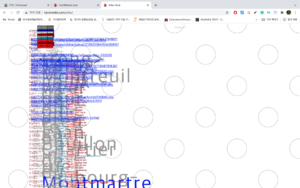 → Soundblog, see Alles...
→ Soundblog, see Alles...
during class G and C learned how to make input-etc etherpad and output-etc etherpad using API!! C IS SUPER EXCITED ABOUT THIS METHOD.
a new lead
week 9, 15th of November / etc. a gate (or a portal) to contamination
Today, during class, everyone presented their prototypes. Ones made in smaller groups, as well as individual projects. The class was very inspiring and the etc. project grew in a new direction. Our target(the etc.), encountered a tool: the contamination tool. Now not only did we want to target the etc. in different content as a gate to the negative space, but wanted to transit our project, turn the etc. into a portal through which anyone could enter, observe excerpts targeted by the filter and insert(a.k.a contaminate) their own content. Then the contaminated content will be returned, seamless, in a parallel publication...
what is contamination
By combining the replace_filter notion presented on monday 15th by Mitsa and Erica, to our etc. filter, C and G could now target the etc&co (see "what is the etc."), to find gates to infiltrate content.
As previously mentioned the etc&co is negative space, a gate to the unmentioned, unworthy, content rejected by lack of time. We want to open up that negative space for others to investigate, contaminate, explore and enjoy. A space where no corners are left unseen.
what kind of content do we want to contaminate
So far C and G have been using the Gutenberg default texts as input to try out the etc. filter. While, it might be a nice field to observe in order to study different genres in literature, the Gutenberg files don't seem like an appropriate fit for our concept. Latest idea has been to convert all the texts we've been given to read in class, that orbit around the topic of the vernacular.
about the format
Also, C and G decided to let go of the format of nomadic publication, a.k.a. yet-to-be-named-publication(see 'week 8, 9th of November / Class with Cristina'). Because it didn't seem like a relevant format anymore. The nomadic publication and the etc. filter became two different projects. In order to accurately engage with the etc. filter, we had to change focus as to the outcome or platform of the publication. It suddenly felt like the most appropriate formate for the etc. filter could only be achieved online. The nomadic publication, which is a physical platform, entailed that we would leave out "negative space" (in this case what could also be called blank space) for people to fill in... This would go against a free input, as people would be constraint in another kind of space we would define prior to giving it to them. When online, the amount of content another wants to contribute is free for them to decide. It can be 'nothing', a space, one word, a sentence, a paragraph, a text → the space will grow with their input, and will not depend of the space given for that input to be filled.
individual session with Clara Balaguer
week 9, 18th of November
G: Ethics & description of the contamination tool
G, feel free to fill in! ʕʘ‿ʘʔ
C: ETC as a portal
C had this unsatisfactory feeling of the role that 'etc.' plays in the contamination(more specifically, replace function). C could not pinpoint what this discomfort was, but during the individual session with Clara, C had a chance to step back and approach 'etc' from a different point of view. Here are some of the interesting things that came up during the discussion with Clara:
- etc as a portal
- etc as a temporal space(etc is where present and future overlaps)
- etc is tightly connected to the context
week 10, 22nd of November, Prototyping class with Michael& Manetta
Michael and Manetta showed C&G how to combine API with HTML form tag. With the help of Manetta, C and G wrote what needs to be done, step by step.
Very importantly, Manetta gave great advice: keeping close to where we started, which is ET CETERA.
Graph update
Also, M and M introduced the magic of Flask! C spent several days reading through Flask and Jinga webpage.
at Varia
week 10, 23rd of November, with Cristina Italic text
Queer API Cristina introduced a project, 'Queer API'. SUPER NICE project!!! U can find more info >>>here(C will link URL tomorrow)<<<
ETC Portal/Contamination Tool
Here are some of the interesting points that came up during the discussion with Cristina:
- Each contaminated content added on to the text? Or every time the contaminated text rebooted so the reader/participant/user starts from the uncontaminated text?
- Interesting word choice: "contamination"=> COVID-related (of course ʅ(◞‿◟)ʃ), the word 'contamination is still a broad enough term allowing some space to the user, the word 'contamination is closely related to 'vernacular(literally meaning vulgar)'
- Which corpora? Which text should we choose?
- One text? Or multiple texts?
- Should we deliberately only give the target_sent(the sentence that contains 'etc.')? Or more(pre_sent/terget_sent/nex_sent) to give the reader some idea of the context? => element of surprise, you can read the whole text(contaminated ver.) later, at the very last. If you give the whole context, then it suddenly became a tool(well this is also nice but...). The gesture of contextualizing and decontextualizing.. those subtle/nuanced shifts of actions. This directly relates to G's interest in how knowledge is passed on, using de-contextualized(quotes, footnotes, references) knowledge to legitimise one's argument.
- What about instead of using a 'replace function'-> using an 'add function' => This is closely related to C's concern/discomfort(see week 9, 18th of November, individual session with Clara Balaguer) and if we add content instead of replacing the content, it stays true to the role of etc as a portal.
- Congratulation token(see C and G's compass thumbnail image):C and G, AGAIN, realize and appreciate C and G's common interest in how to encourage ppl to participate, make this project more accessible and playful.
- How can we push even further, the aspect of contamination?
- Need to be careful and mindful about the fact that you are inserting something into someone else's text => reminds Aymeric's lecture on copyright (=>MAYBE C and G can use Aymeric's PhD thesis?! 💥🤯 WILD 🤯💥)
- Queer API => goooood reference, customized error messages
- Which language will C and G choose to invite the reader/participant/user => put this info at the very end... G said something about easter egg
- Which format could be used in terms of the distribution? => button of share, print, display uncontaminated ver./contaminated ver., ...
- Collective authorship/How to handle conflict(meaning when two ppl are trying to contaminate at the same time) => Flask session maybe?, API policy about the conflict, can it be real-time as Etherpad?(C's afterthought)
- How should we deal with the contaminants? => moderation(?), list of words that rejects certain words
- ETC is used when the author, writer, speaker wants to give some examples to make a point => which resonates with the specificity in vernacular
- API closely connects to the aspect of contamination => extending and spreading, MORE PPL! MORE DISTRIBUTION! VIRAL!
early-stage plans
week 8, 9th of november / class with Cristina After having a check-in moment and group discussion with Cristina from 10:00 - 17:30(!!), G and C agreed on the following things:
1) filter etc & co
→ synonyms
→ gate to the negative space
in notebook/logbook (Jupyter-like layout),
2) Run the filter etc & co
→ use the filter to find negative space in content online(things that we wrote in etherpads, NLTK corpora, references gathered by XPUB1 and Cristina, Steve, Manetta, and Michael)
3) yet-to-be-named-publication
→ physical publication
→ annotations/updates can go back to the notebook
→ logbook as intro
→ the instructions
→ negative space waiting to be filled
4) And others(Mainly documentation)
→ track and tracing nomadic publication
→ C and G delivery service, pick-up
→ hand-to-hand
→ last reader/author chooses the next one
...back to number 1), full circle ⥀
This plan aimed to have an ongoing publication in which we would welcome a collaborative authorship with a common input and multiple outputs.
week 8, 13th of november / meeting at C's house
For the greater good of the special Issue 16, every subgroup agreed to submit in a group meeting a proposal, crossing inputs from the different projects in order to create a coherent issue. The following steps were submitted to the group meeting on the 16th of Tuesday, C and G had a meeting prior to decide on the important points.
1/ What is the content?
A step-by-step journey in our research
Gather SI16 Research (since September: Pads, Glossary, Prototype) → edit research
Picking and gathering in the field of thoughts, our vernacular content, our fragmented yet somewhat related contents
2.1/ Editorial Process
The online and printed publications are two sides of the same publication, they do not echo each-other but complete one another. (publish content that is more suitable for online goes online)
Make a research-catalogue/reader (a printed-part and an online one that can be filled in different ways). (ex: the space try-out platform where everyone can add comments on the screen-content)
Both printed&online publications should have a negative space/blanks for the public to fill-in —> enable different publics/ways to interact with content
2.2/ Curatorial Process
Curate publications in the space of VARIA
Within event that also needs a shape
Find Identity SI16
Prepare interaction with public (how do we encourage them to be part of our research?)
3/ At Varia
Engage with the public on our research-catalogue/reader, talks on the different sections/chapters/subjects we engaged with
Make public react to certain instructions to fill-in negative space with their process/thoughts
(Ex: what is vernacular language? Maybe you have something for us to illustrate a kind of vernacular with us, what is the last message you send today? Can you add it to the publication?)
Guided discussions to enable accessibility, welcome all kinds of discourse
sample instructions might be as such:
- pick and share your oldest memo in your memo app
- pick and share your latest text message
- pick and share one picture from your photo album
- pick and share one of the unclosed web page content
4/ outro
The launch of SI16 will be the occasion of welcoming the public into the publications, the process of a publication and its growth. The printed-parts will be distributed to the last visitors in order for them to keep adding to the content and the keys to the online-part of the publication will be spread for it to also continue growing.
Has the publication an anonymous input or is it a thread of added authors? (Both options can also work together)
week 10, 26th of november / group session with Danny van der Kleij Danny THE programmer made some suggestions on the overall structure of the project website and self-reflective text, for seed text.
week 11, 29th of november / Michael and Manetta, THE SAVIOR
Before the prototyping class on week 11, C and G wrote technical questions about how to write a code that actually functions(😂).
Michael guided us through how to achieve C and G's vision(?) and after prototyping class C was like..
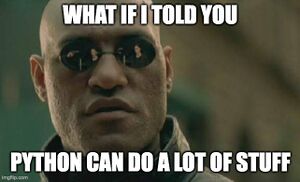
(C: hmmm.. not the best/appropriate meme, will change that later!)
Colophon
Reference
- https://gitlab.com/siusoon/queer-motto-api/
- https://hackersandslackers.com/flask-routes
- https://www.w3schools.com/tags/tryit.asp?filename=tryhtml5_ev_onclick
Credits
Cristina
Clara
Michael
Manetta
C and G

